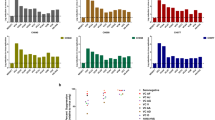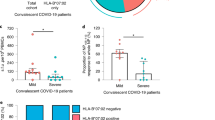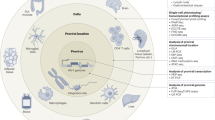Abstract
The contribution of HLA class II–restricted CD4+ T cell responses to HIV immune control is poorly defined. Here, we delineated previously uncharacterized peptide-DRB1 restrictions in functional assays and analyzed the host genetic effects of HLA-DRB1 alleles on HIV viremia in a large cohort of HIV controllers and progressors. We found distinct stratifications in the effect of HLA-DRB1 alleles on HIV viremia, with HLA-DRB1*15:02 significantly associated with low viremia and HLA-DRB1*03:01 significantly associated with high viremia. Notably, a subgroup of HLA-DRB1 variants linked with low viremia showed the ability to promiscuously present a larger breadth of peptides with lower functional avidity when compared to HLA-DRB1 variants linked with high viremia. Our data provide systematic evidence that HLA-DRB1 variant expression has a considerable impact on the control of HIV replication, an effect that seems to be mediated primarily by the protein specificity of CD4+ T cell responses to HIV Gag and Nef.
This is a preview of subscription content, access via your institution
Access options
Subscribe to this journal
Receive 12 print issues and online access
$209.00 per year
only $17.42 per issue
Buy this article
- Purchase on Springer Link
- Instant access to full article PDF
Prices may be subject to local taxes which are calculated during checkout



Similar content being viewed by others
References
Aubert, R.D. et al. Antigen-specific CD4 T-cell help rescues exhausted CD8 T cells during chronic viral infection. Proc. Natl. Acad. Sci. USA 108, 21182–21187 (2011).
Wilkinson, T.M. et al. Preexisting influenza-specific CD4+ T cells correlate with disease protection against influenza challenge in humans. Nat. Med. 18, 274–280 (2012).
Soghoian, D.Z. et al. HIV-specific cytolytic CD4 T cell responses during acute HIV-1 infection predict disease outcome. Sci. Transl. Med. 4, 123ra25 (2012).
Whitmire, J.K. Induction and function of virus-specific CD4+ T cell responses. Virology 411, 216–228 (2011).
Soghoian, D.Z. & Streeck, H. Cytolytic CD4+ T cells in viral immunity. Expert Rev. Vaccines 9, 1453–1463 (2010).
Streeck, H., D'Souza, M.P., Littman, D.R. & Crotty, S. Harnessing CD4+ T cell responses in HIV vaccine development. Nat. Med. 19, 143–149 (2013).
Douek, D.C. et al. HIV preferentially infects HIV-specific CD4+ T cells. Nature 417, 95–98 (2002).
Ranasinghe, S. et al. HIV-specific CD4 T cell responses to different viral proteins have discordant associations with viral load and clinical outcome. J. Virol. 86, 277–283 (2012).
Carrington, M. & Walker, B.D. Immunogenetics of spontaneous control of HIV. Annu. Rev. Med. 63, 131–145 (2012).
International HIV Controller Study. The major genetic determinants of HIV-1 control affect HLA class I peptide presentation. Science 330, 1551–1557 (2010).
Apps, R. et al. Influence of HLA-C expression level on HIV control. Science 340, 87–91 (2013).
Malhotra, U. et al. Role for HLA class II molecules in HIV-1 suppression and cellular immunity following antiretroviral treatment. J. Clin. Invest. 107, 505–517 (2001).
Julg, B. et al. Possession of HLA class II DRB1*1303 associates with reduced viral loads in chronic HIV-1 clade C and B infection. J. Infect. Dis. 203, 803–809 (2011).
Southwood, S. et al. Several common HLA-DR types share largely overlapping peptide binding repertoires. J. Immunol. 160, 3363–3373 (1998).
Gerlach, J.T. et al. Minimal T-cell-stimulatory sequences and spectrum of HLA restriction of immunodominant CD4+ T-cell epitopes within hepatitis C virus NS3 and NS4 proteins. J. Virol. 79, 12425–12433 (2005).
Schulze zur Wiesch, J. et al. Broad repertoire of the CD4+ TH cell response in spontaneously controlled hepatitis C virus infection includes dominant and highly promiscuous epitopes. J. Immunol. 175, 3603–3613 (2005).
Gao, X. et al. Effect of a single amino acid change in MHC class I molecules on the rate of progression to AIDS. N. Engl. J. Med. 344, 1668–1675 (2001).
Trachtenberg, E. et al. Advantage of rare HLA supertype in HIV disease progression. Nat. Med. 9, 928–935 (2003).
Mallone, R. et al. Functional avidity directs T-cell fate in autoreactive CD4+ T cells. Blood 106, 2798–2805 (2005).
Caserta, S. et al. Reduced functional avidity promotes central and effector memory CD4 T cell responses to tumor-associated antigens. J. Immunol. 185, 6545–6554 (2010).
Streeck, H., Frahm, N. & Walker, B.D. The role of IFN-γ Elispot assay in HIV vaccine research. Nat. Protoc. 4, 461–469 (2009).
Acknowledgements
We thank all individuals whose participation enabled this study. This study was funded by the US National Institutes of Health (NIH) (R01 AI091450 and R01 AI094602). H.S. is funded through R01 AI091450 and R01 AI094602 and the Henry M. Jackson Foundation by a cooperative agreement between the Henry M. Jackson Foundation for the Advancement of Military Medicine and the US Department of Defense (W81XWH-07-2-0067). S.R. is supported by a Harvard CFAR Scholar Award (NIH/National Institute of Allergy and Infectious Diseases (NIAID) 5P30AI060354-09), Center for HIV/AIDS Immunology and Immunogen Discovery (CHAVI-ID) and MGH Executive Committee on Research Fund for Medical Discovery. This project has also been funded in part with federal funds from the US Intramural Research Program of the US National Institutes of Health, National Cancer Institute (NCI), Center for Cancer Research, under contract HHSN261200800001E. The UCSF SCOPE cohort was supported by the Centers for AIDS Research at UCSF (PO AI27763), CFAR Network of Integrated Systems (R24 AI067039), the UCSF Clinical and Translational Science Institute (UL1 RR024131), and NIAID (RO1 AI087145 and K24 AI069994). The MGH cohort was supported by the Mark and Lisa Schwartz Foundation and the Collaboration of AIDS Vaccine Discovery of the Bill & Melinda Gates Foundation. This research has been supported in part by the International HIV Controllers Study, funded by the Bill & Melinda Gates Foundation, the AIDS Healthcare Foundation and CFAR, an NIH-funded program (P30 AI060354) that is supported by the following NIH Co-Funding and Participating Institutes and Centers: NIAID, NCI, National Institute of Child Health and Human Development, National Heart, Lung, and Blood Institute, National Institute on Drug Abuse, National Institute of Mental Health, National Institute on Aging, Fogarty International Center and Organization for Autism Research. We thank M. Ghebremichael for statistical assistance and Y. Yuki for HLA genotyping. The content of this publication does not necessarily reflect the views or policies of the US Department of Health and Human Services, nor does mention of trade names, commercial products or organizations imply endorsement by the US Government.
Author information
Authors and Affiliations
Contributions
S.R. designed the study, performed experiments, analyzed data, and wrote the manuscript; S.C., I.D., R.L., D.Z.S., G.K., M.D.F., M.L., B.K. and G.A. contributed to in vitro studies and experimental design; J.S. and A.S. generated the HLA-DR–transfected L cells and conducted peptide–HLA-DRB1 binding assays; Y.Q., X.G. and M.C. performed high-resolution HLA typing and analyzed HLA-DRB1 associations with viral control; S.G.D. and B.D.W. provided clinical samples from HIV-infected subjects enrolled in the SCOPE and MGH cohorts; M.C. and B.D.W. gave intellectual input; H.S. conceived of and designed the study, analyzed data, wrote the manuscript and was responsible for the overall study.
Corresponding author
Ethics declarations
Competing interests
The authors declare no competing financial interests.
Supplementary information
Combined PDF
Supplementary Figures 1–3 and Supplementary Tables 1–5 (PDF 339 kb)
Rights and permissions
About this article
Cite this article
Ranasinghe, S., Cutler, S., Davis, I. et al. Association of HLA-DRB1–restricted CD4+ T cell responses with HIV immune control. Nat Med 19, 930–933 (2013). https://doi.org/10.1038/nm.3229
Received:
Accepted:
Published:
Issue Date:
DOI: https://doi.org/10.1038/nm.3229
This article is cited by
-
Employing computational tools to design a multi-epitope vaccine targeting human immunodeficiency virus-1 (HIV-1)
BMC Genomics (2023)
-
HLA-SPREAD: a natural language processing based resource for curating HLA association from PubMed abstracts
BMC Genomics (2022)
-
Low CCR5 expression protects HIV-specific CD4+ T cells of elite controllers from viral entry
Nature Communications (2022)
-
MHC Haplotyping of SARS-CoV-2 Patients: HLA Subtypes Are Not Associated with the Presence and Severity of COVID-19 in the Israeli Population
Journal of Clinical Immunology (2021)
-
Mucosal and systemic SIV-specific cytotoxic CD4+ T cell hierarchy in protection following intranasal/intramuscular recombinant pox-viral vaccination of pigtail macaques
Scientific Reports (2019)



